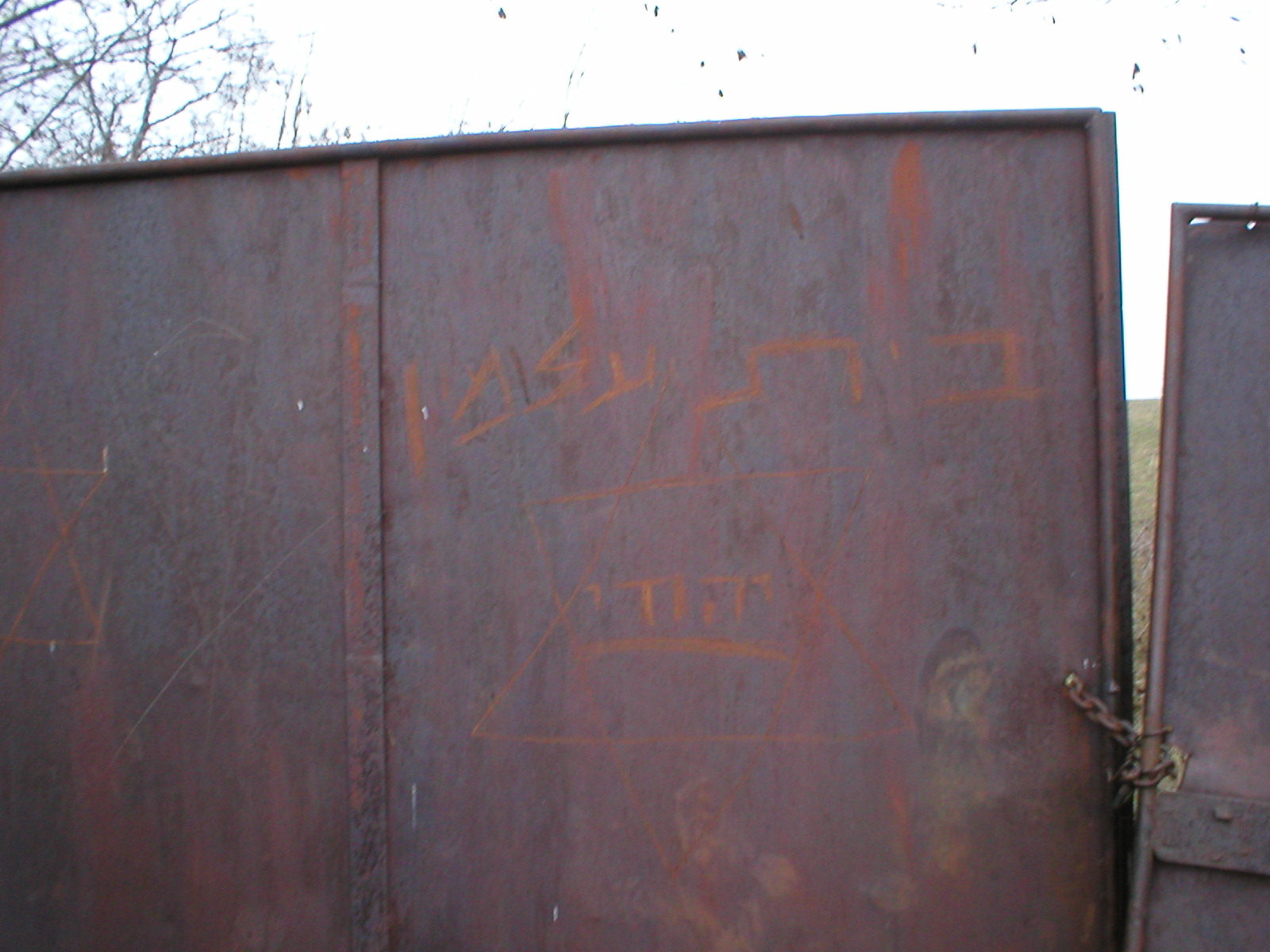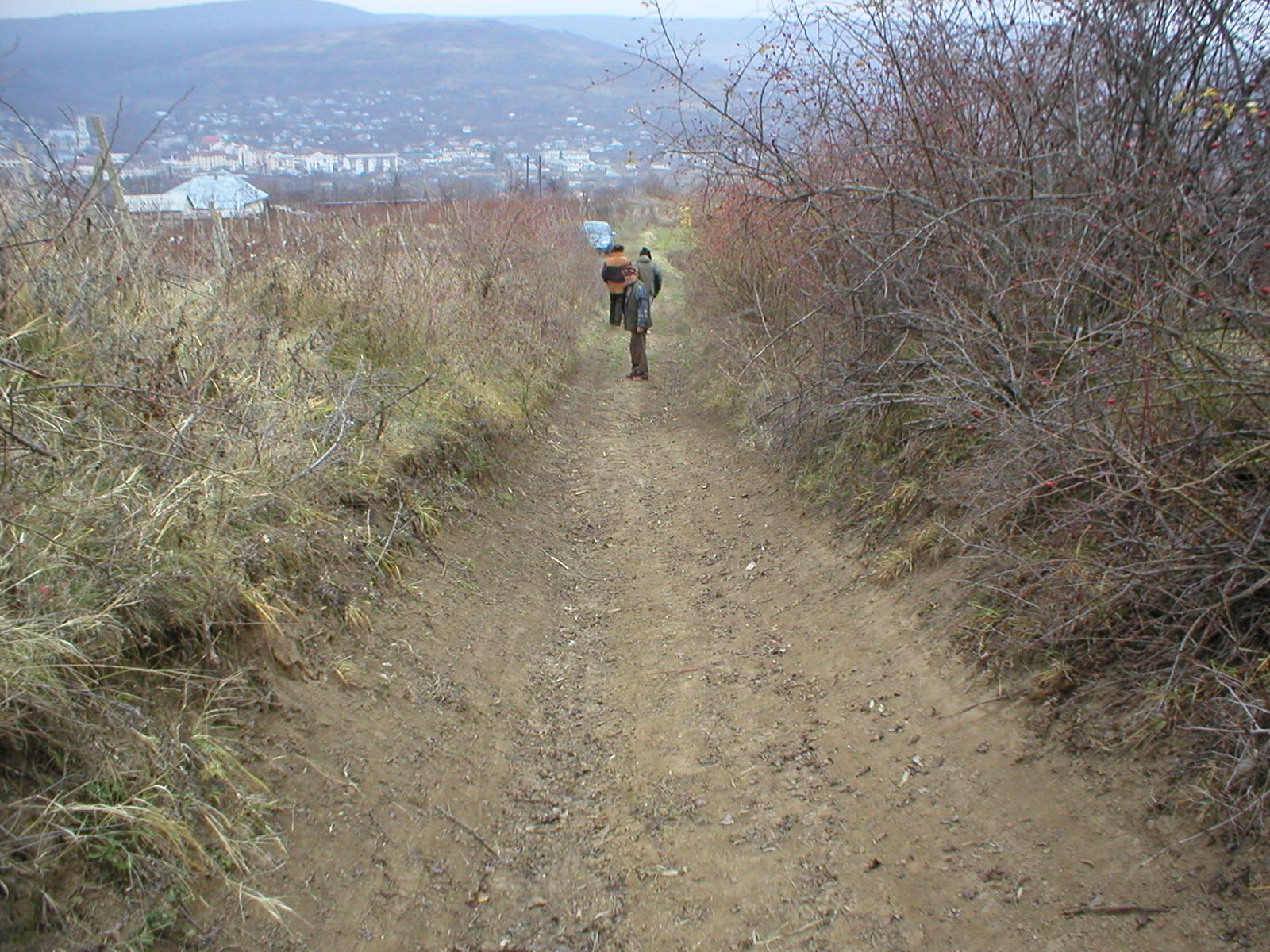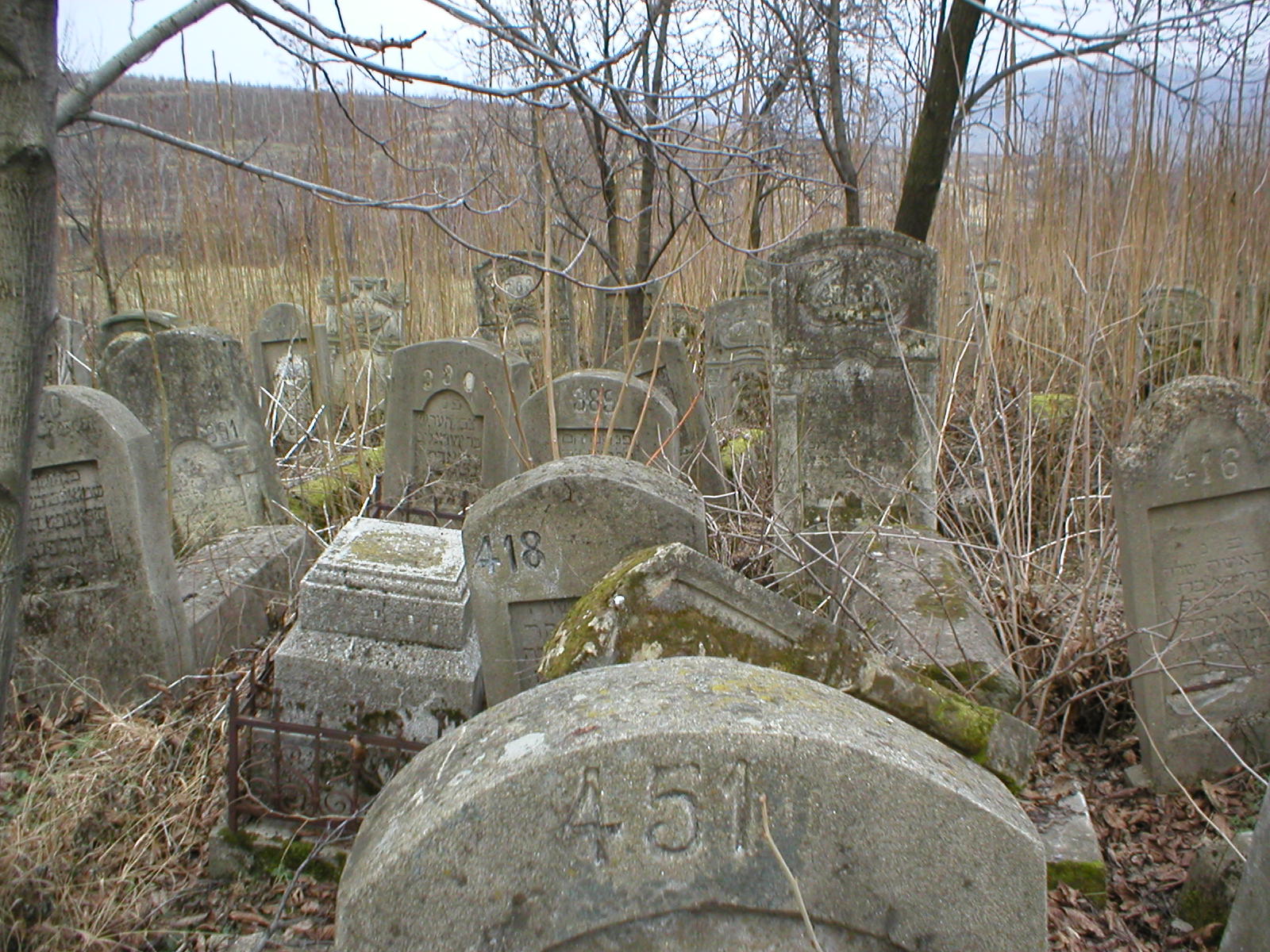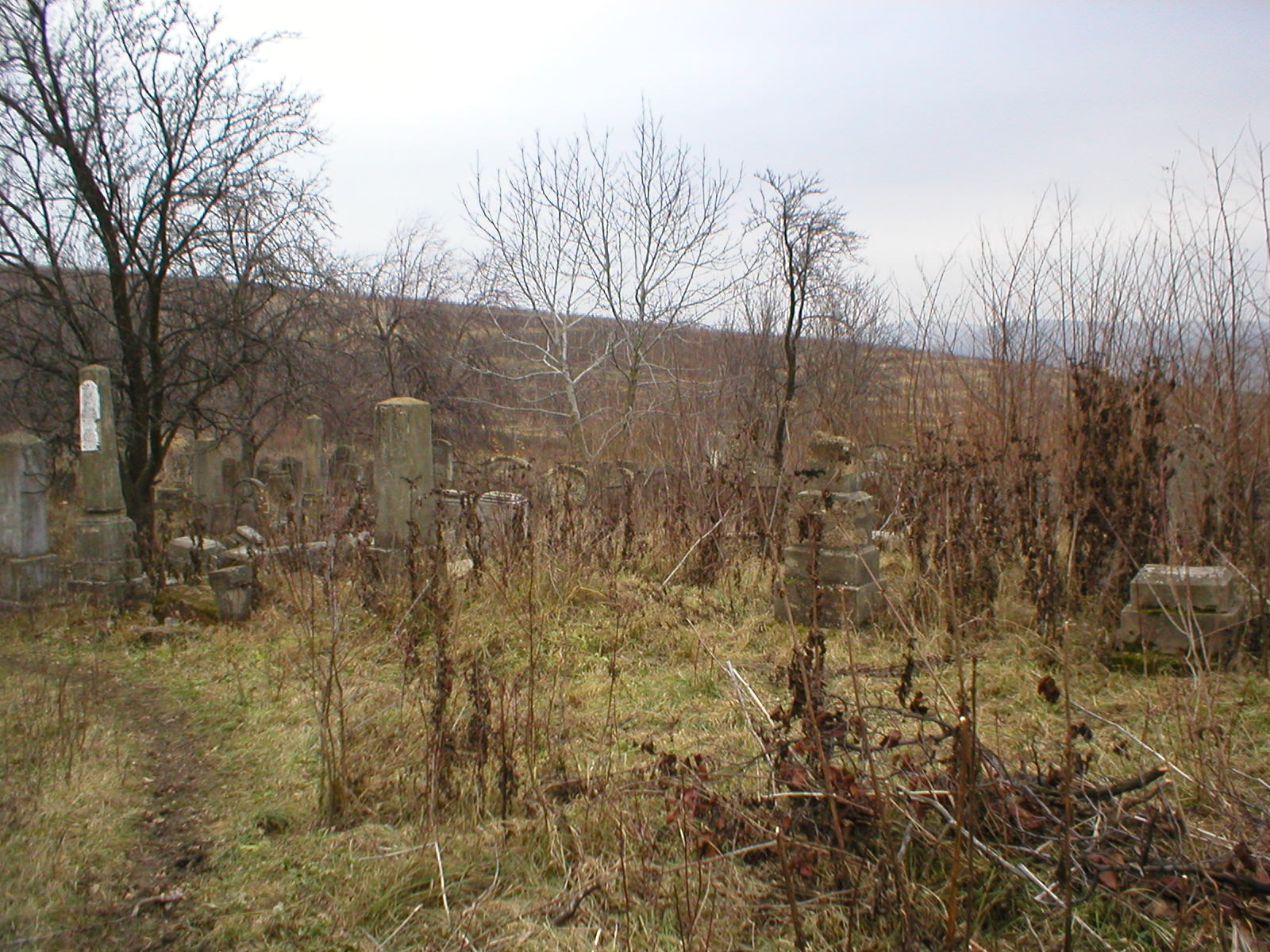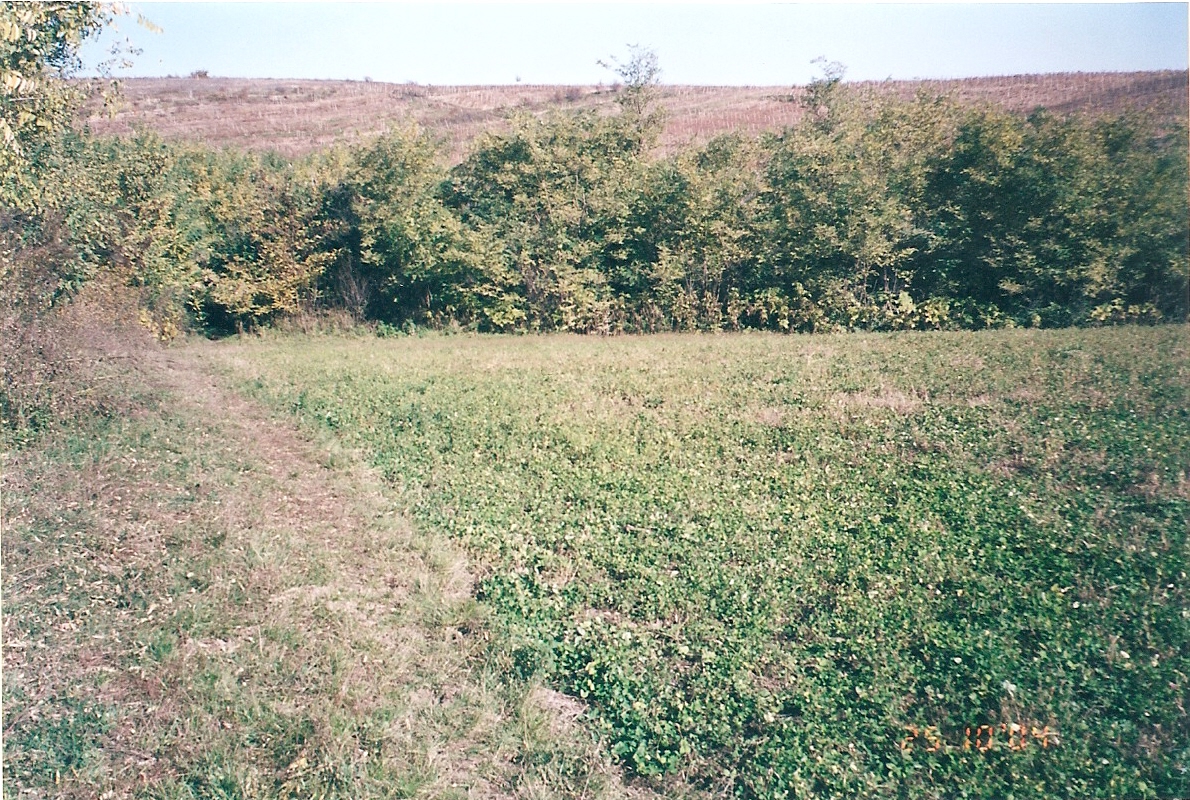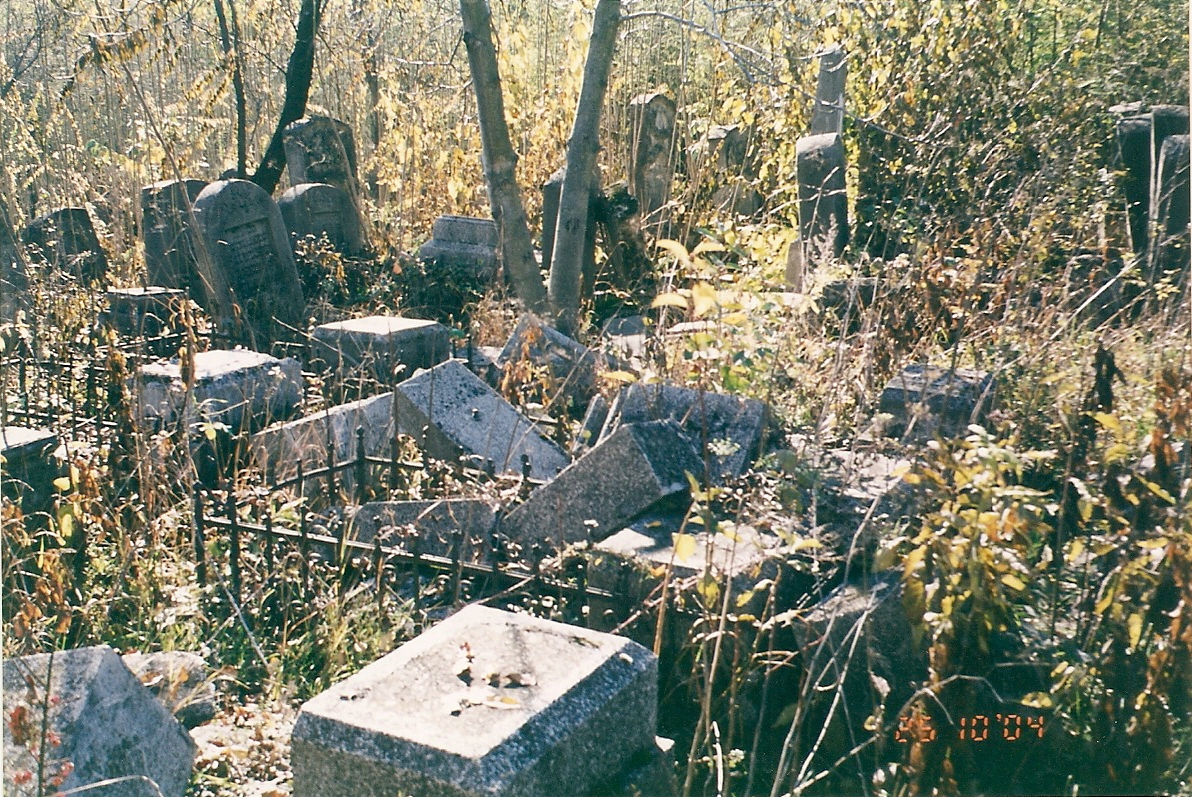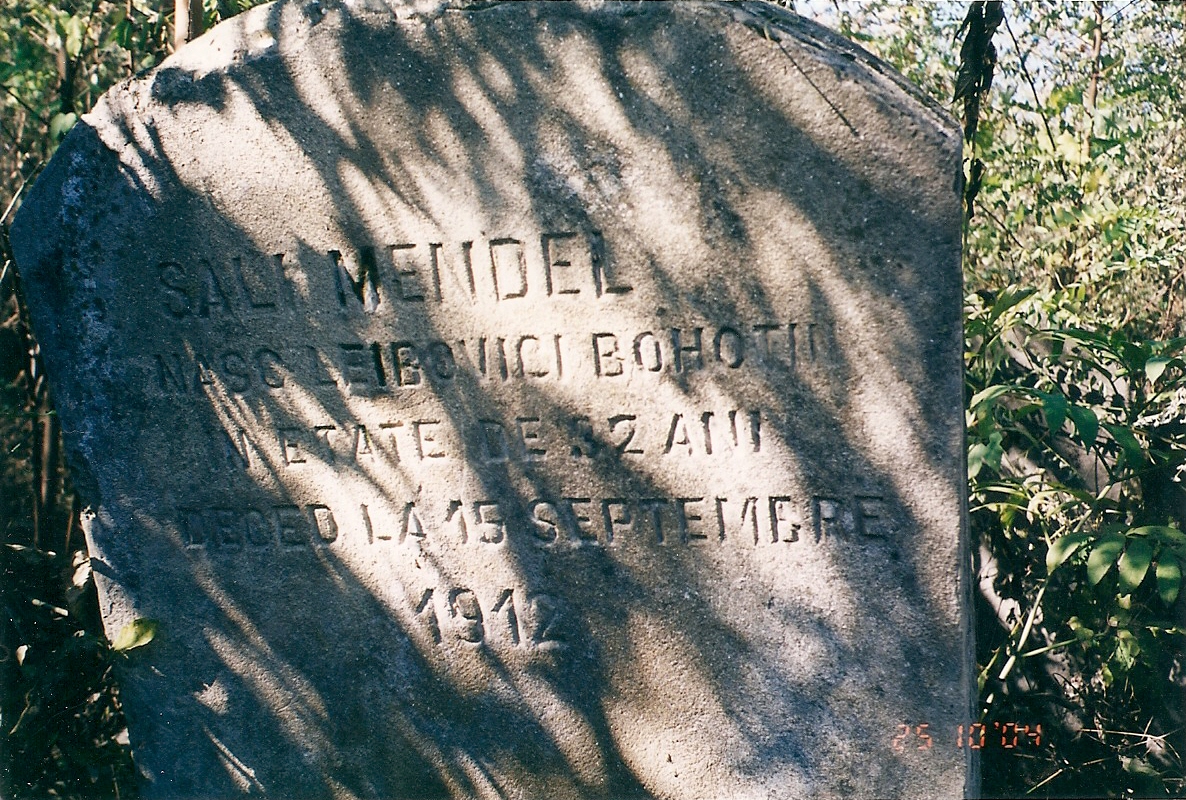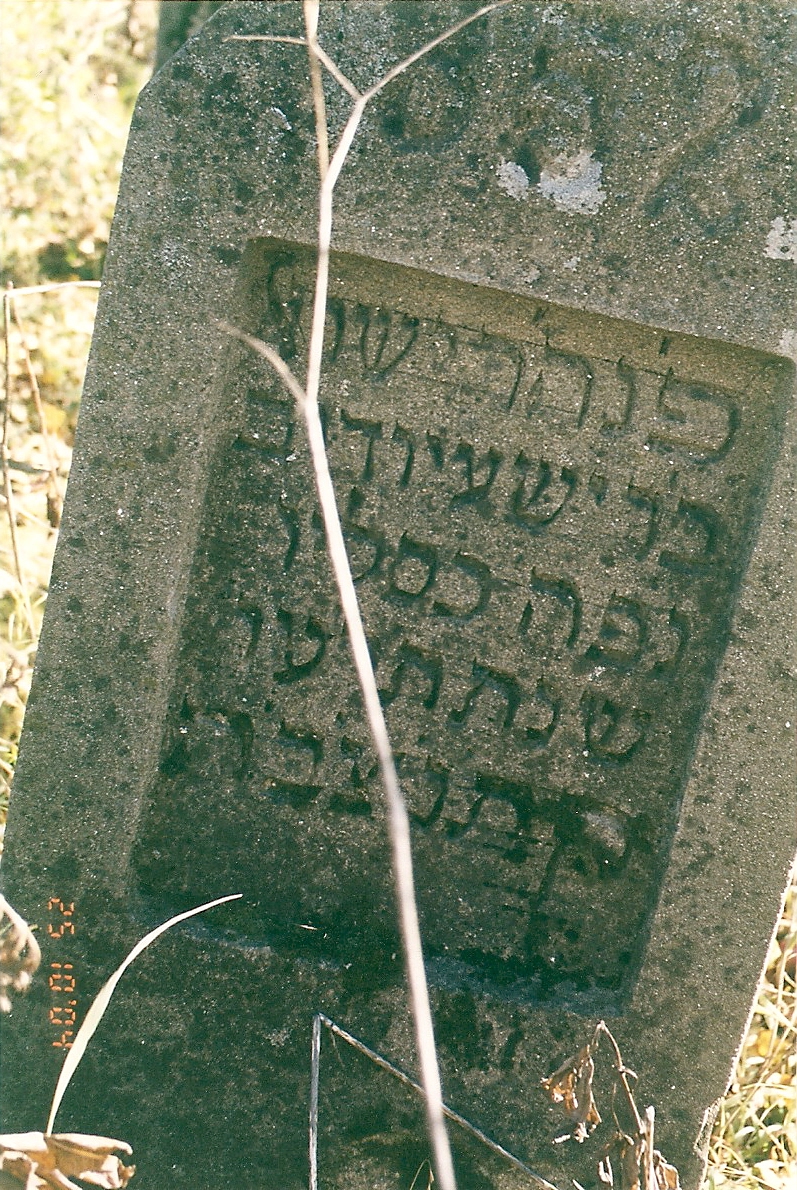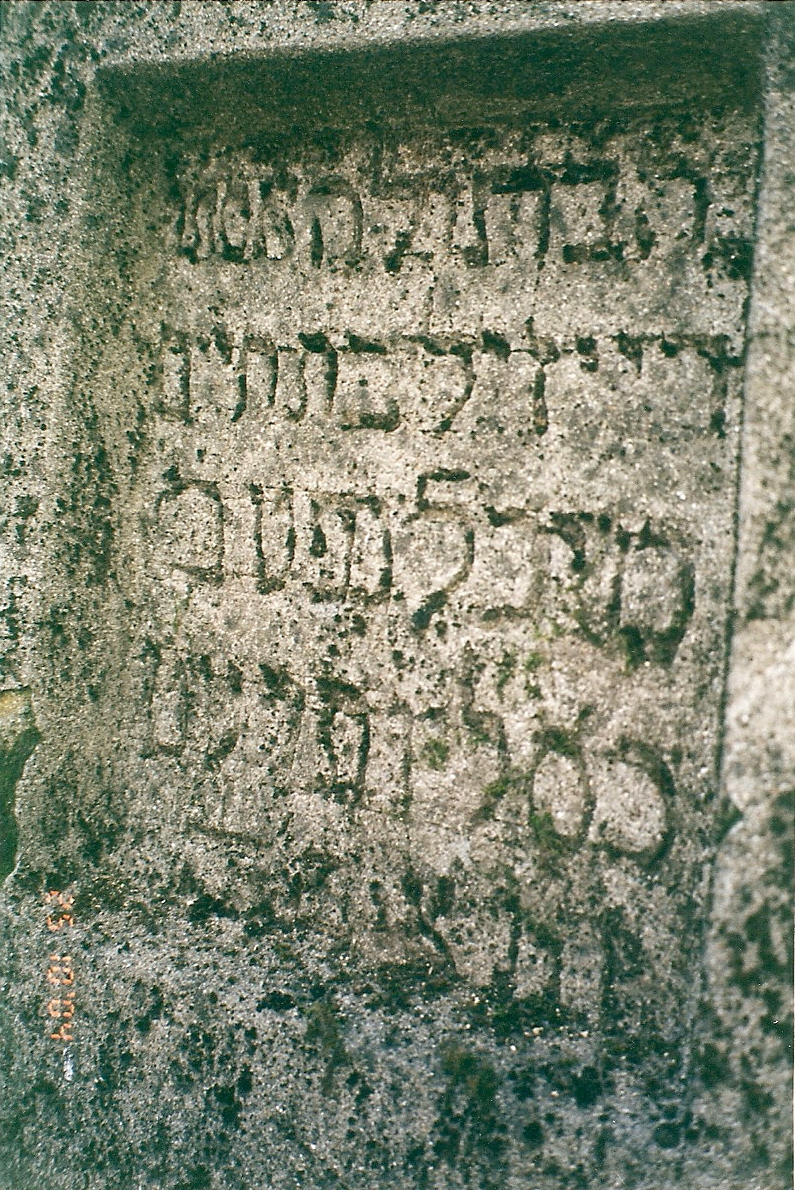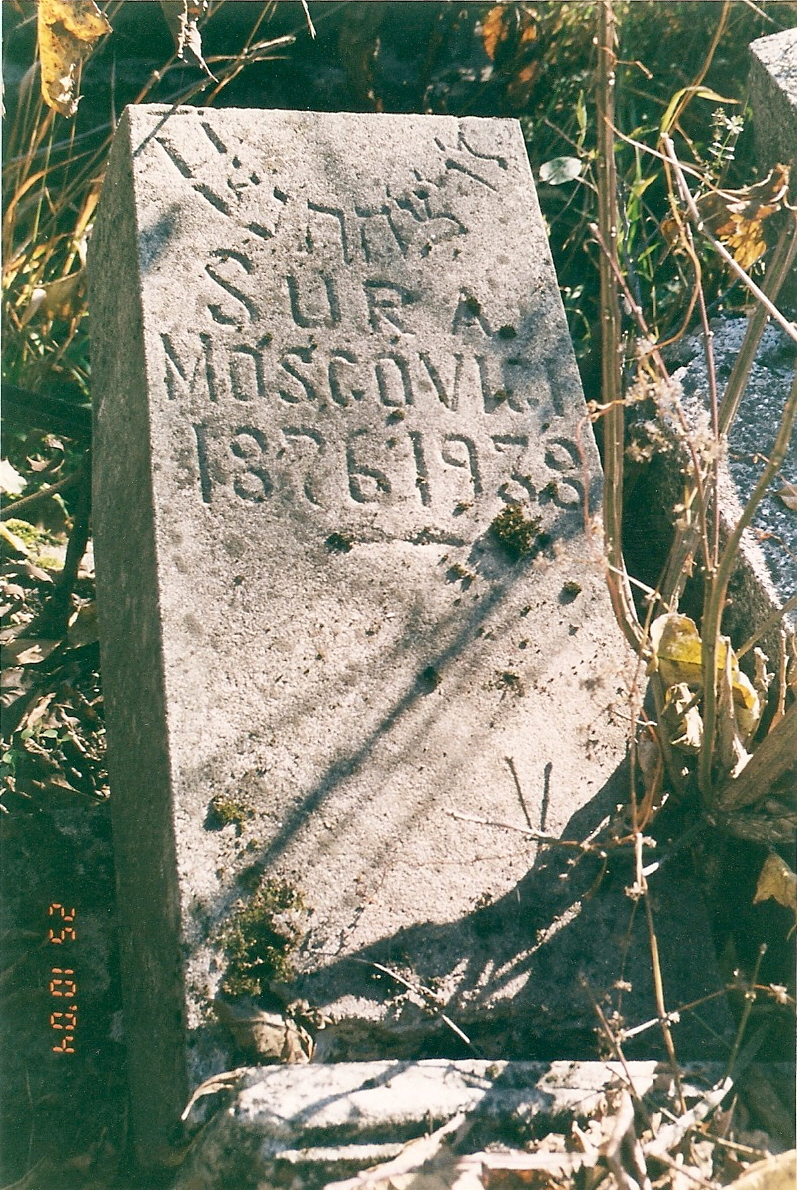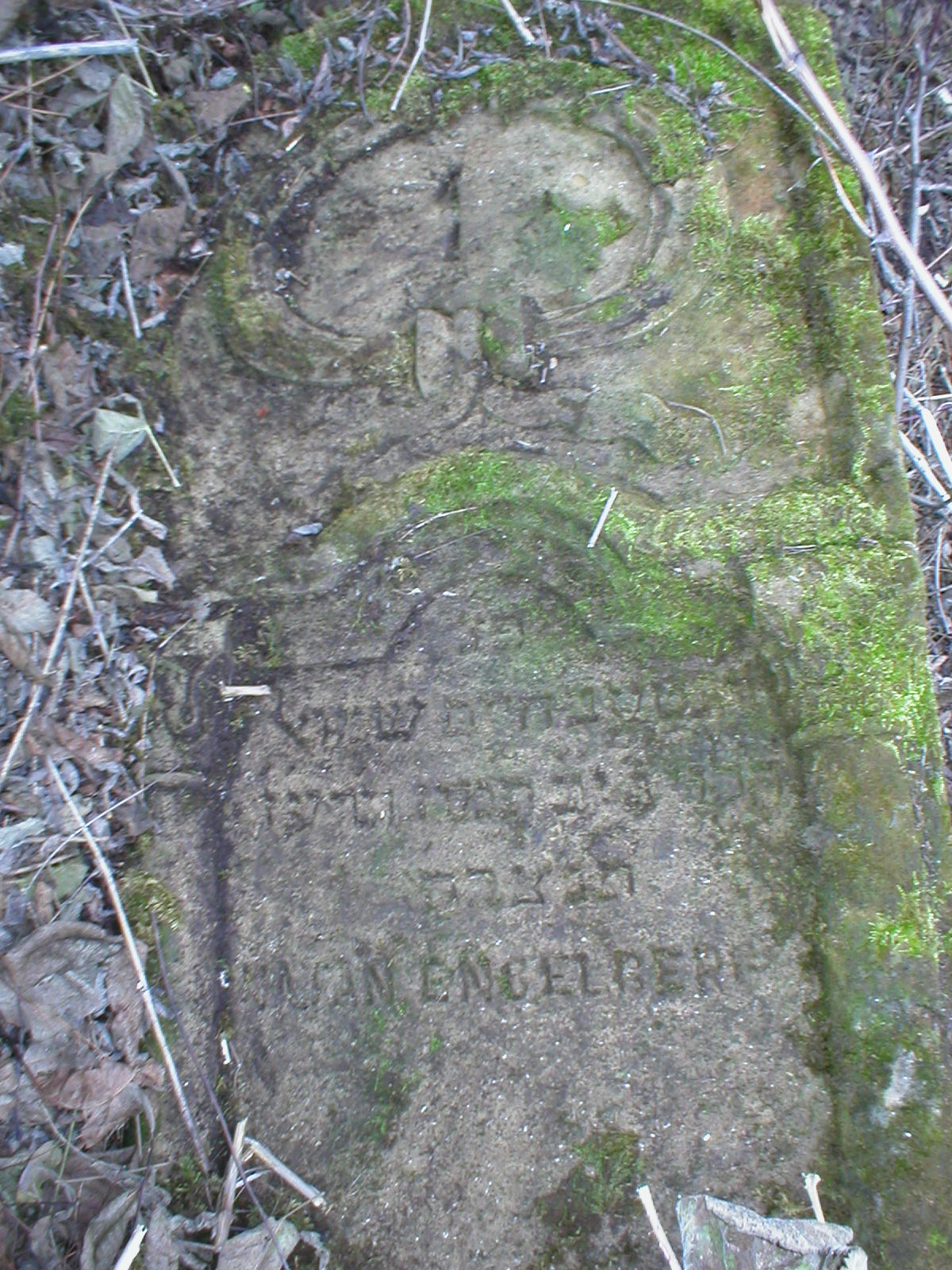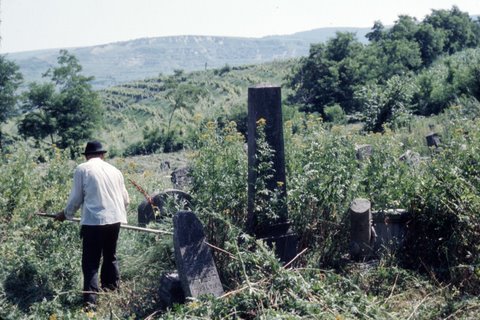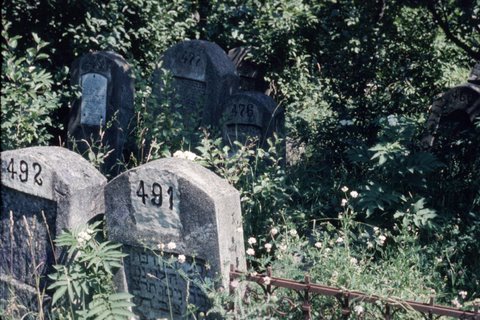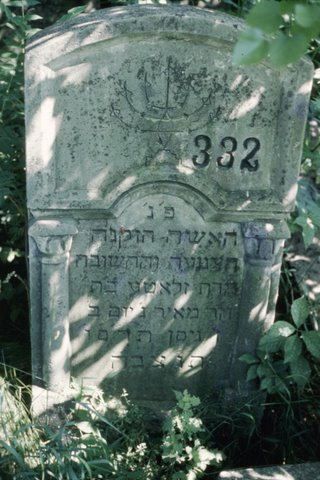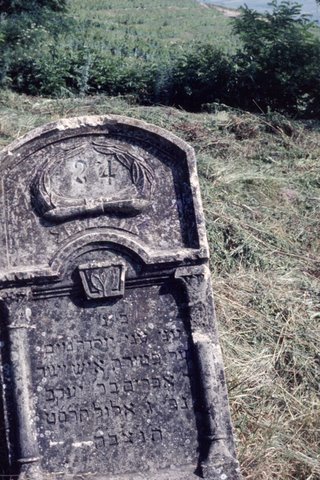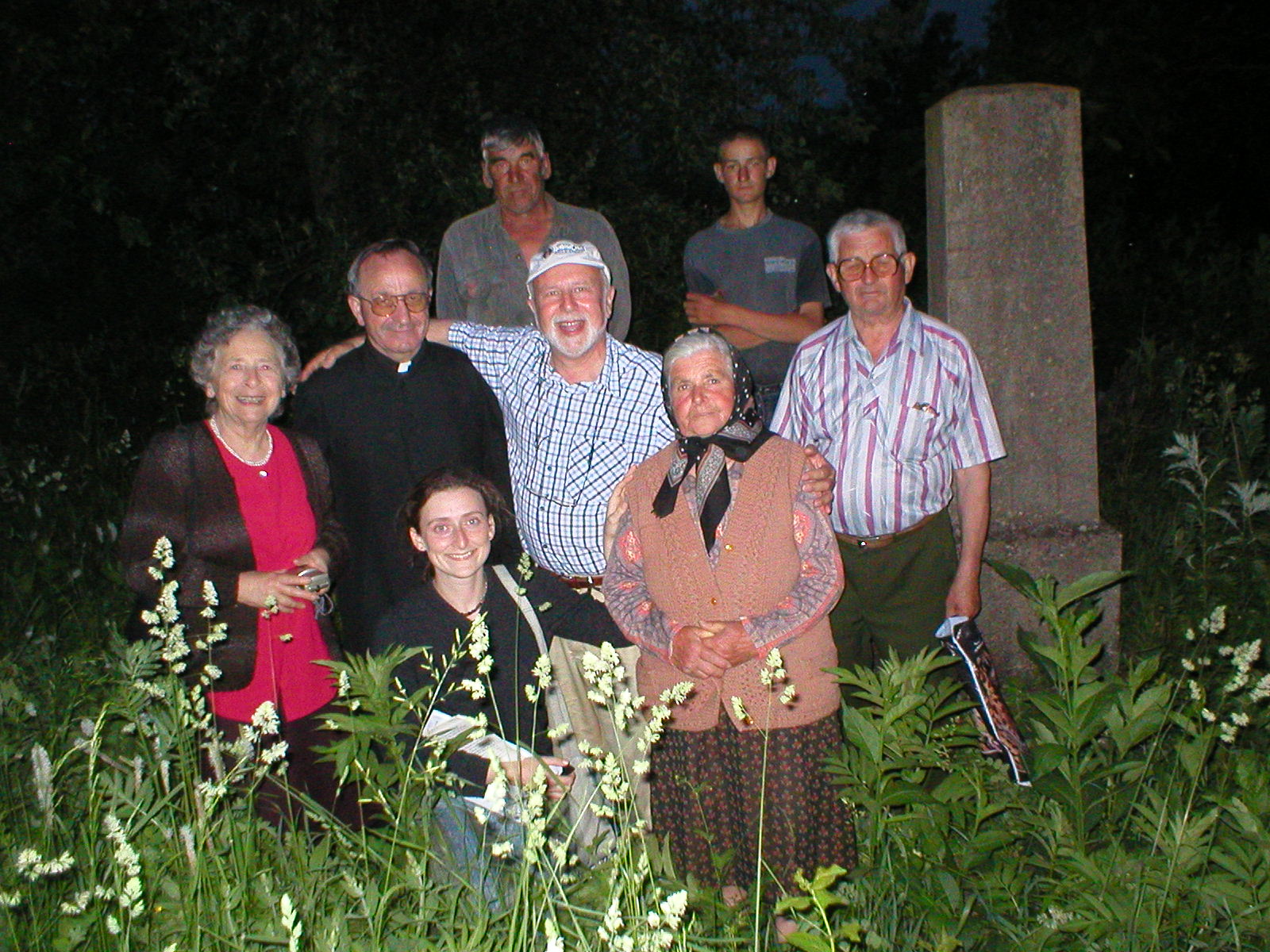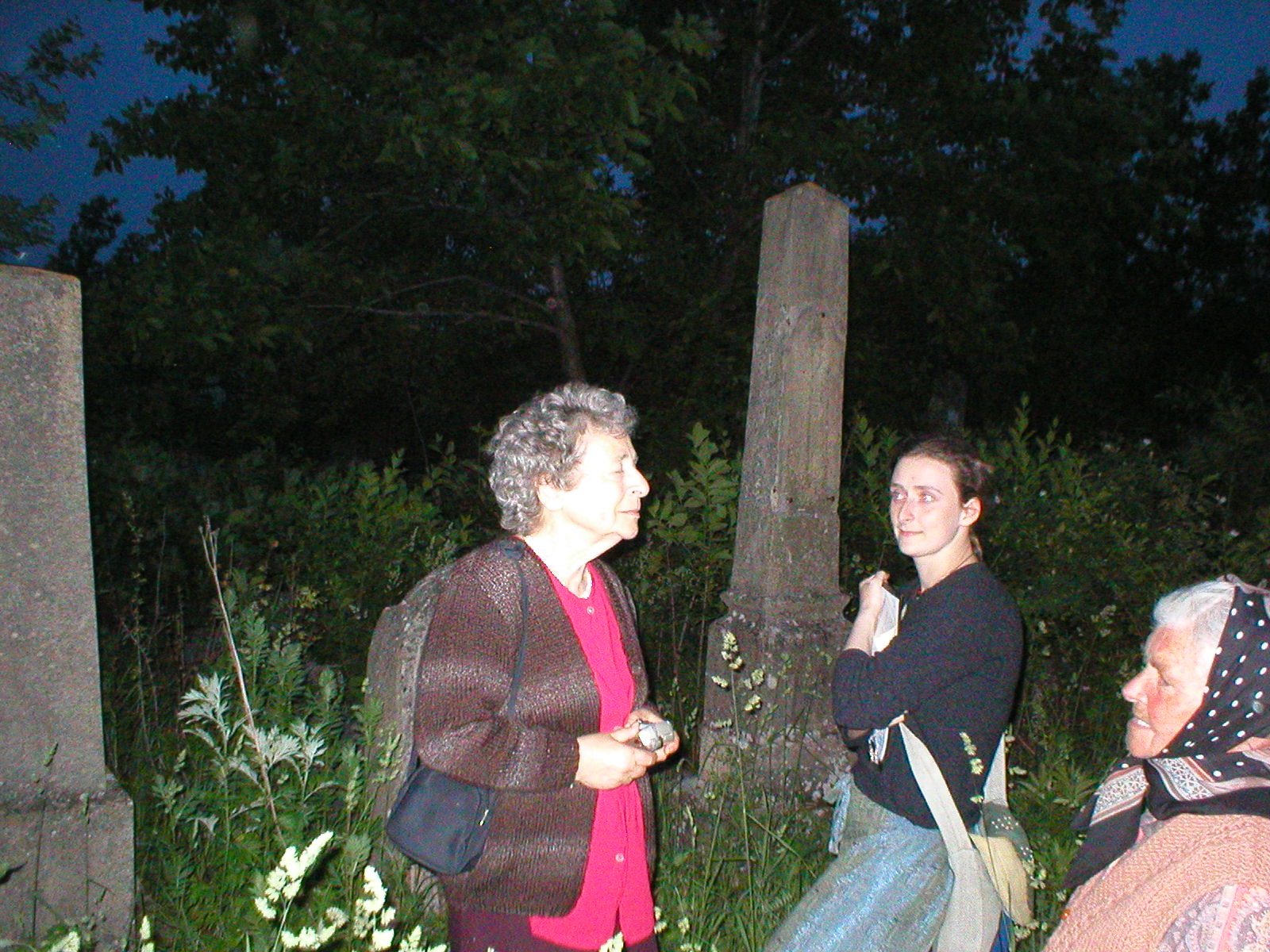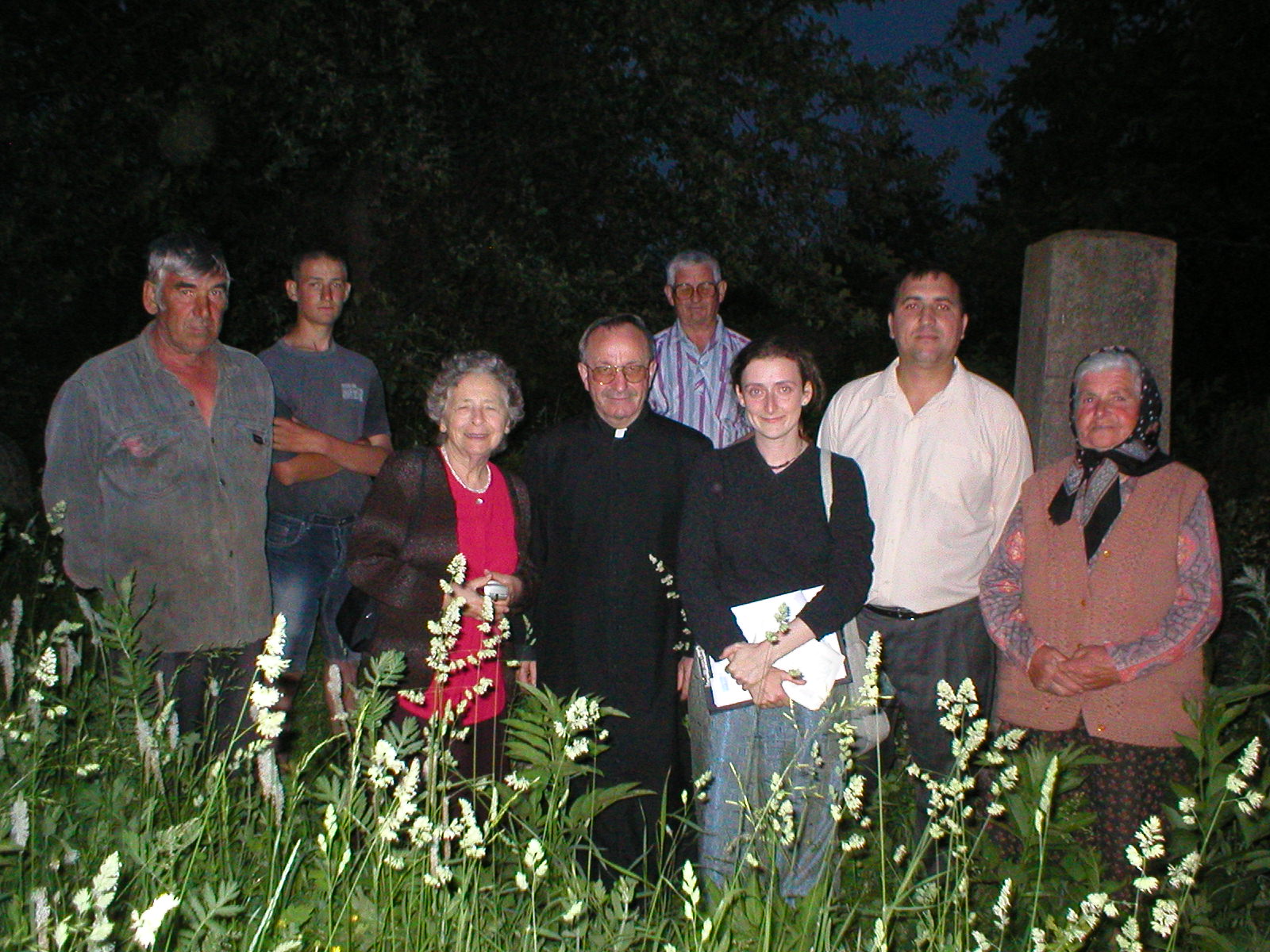 |
| Contents: תוכן: |
| Rǎducǎneni Home Page |
| History |
| Pre-Settlement |
| A
Vanished World |
| Cronica Bohotinului By Radu Rosetti |
| Romanian Census & Civil Records |
| Julian Calendar |
| Synagogue |
| Cemetery |
| In Memoriam |
| River Prut |
| Views |
| Jewish
School |
| Family Album |
| The Hora |
| Links in Rǎducǎneni |
| Jewishgen Links |
| Link to Iasi |
| Link
to Husi |
| Compiled by
Marcel Glaskie Contact: Marcel Glaskie Dated: July 2010 Copyright © 2010 Marcel Glaskie Webpage Design by Marcel Glaskie |
Jewish Cemetery
בית עלמין יהודי
Latitude 46° 58' 9.12 N Longditude 27°56' 48.48 E
| Sub directory Romanian - Hebrew |
| Earliest Death
Register 1850 In the 1852 Death Register five deaths all buried in Iasi In 1864 four in Husi & one in Iasi The first recorded burials in Raducaneni were 15 in 1866 |
| Click on link below
to see each grave by its plot number: |
| photosofgraves |
| Click on the link
below to see general views around the cemetery: |
| Cemetery Views |
| Ion Balint
(Tel: 0765 820 593) Key holder for the Jewish Cemetery |
| Latest from Google Earth Showing grave stones as white dots |
In May 2011, Marcel Glaskie went for the third time to Raducaneni where he engaged six local labourers to work for a week in the Jewish cemetery as part of a personal restoration project. Their task was to cut down the trees and wild, overgrown vegetation in order to expose all the gravestones and then to clean the inscriptions on the stones.
When this was done, Marcel Glaskie surveyed the area and drew up a detailed plan of all the graves. He took photographs of all the graves with visible inscriptions and it is hoped that they will appear in this site in the near future.
Marcel Glaskie found an area with gravestones relating to the earliest days of Jewish settlement in Raducaneni and is reasonably convinced there is only one Jewish cemetery. The results of his research contradict the official surveys which claim that there are two cemeteries in the small township.
Details
of the cemetery as it is today appear below.
______________________________________________________________
The Jewish Cemetery
in Rǎducǎneni
May 2011
The Jewish cemetery located 2.2
km from the town centre, high on a hill north-east of
the town, remains as a valuable historical record of
the Jewish people who conducted the commercial life of
19th century Rǎducǎneni
The original Jewish community,
invited by the Hatman Raducanu
Roset, probably
came to Rǎducǎneni in the late 1830s from
Galicia for the purpose of creating a
commercial hub on the main highway, halfway between
Iasi and Husi
According to Mr. Ion Balint, the
caretaker and key holder of the Jewish cemetery, there
are 570 Jewish graves
Most of the gravestones have the
plot number cut in the face of the monuments. The plot numbers, however, have no bearing on
the date of the burial. It is quite obvious that
people in the Jewish community purchased their burial
plots long before they died, probably to finance the
purchase of the land and the establishment and
maintenance of the Jewish cemetery. For example, plot
number 1 (one), in the area called the old cemetery
bears the inscription Natan Engelberg and is dated 12th
Tamuz 5677 = July 1918
Probably the oldest grave in the cemetery, is
plot number 148 (one hundred and forty eight) located
in the area called the new cemetery. The date on the
stone is in Hebrew 19th Tamuz 5626 = July
1867. The inscription reads “The boy, Chaim David son of Yehudah Leib”. There is no family
name
The last burial plot is that of Moise Malca
dated April 16, 1983
The cemetery area of 2.62 hectares is
enclosed by a modern wire fence fixed to concrete
posts and metal gates at the south west corner, which
replaced the original wooden fence. The original
entrance was about 214 meters beyond the existing
metal gates
Inside the original entrance there once stood
a a mortuary hall (Ohel in
Hebrew). This construction was used for washing and
preparing the corpse for burial (Tahara in
Hebrew). It was also used for short burial services
and eulogies before internment. The Ohel received its
water supply from a nearby spring
Adjacent to the Ohel is an unmarked gravestone,
which was probably the place traditionally designated
for burying dilapidated prayer books and other sacred
writings, which contained the holy name of the Creator
In September 2011, Marcel Glaskie went for the fourth time to Rǎducǎneni, where he engaged eight local labourers to work for nine days in the Jewish cemetery, as phase two of a personal restoration project, sponsored by Jewish families from around the world, who originated from Rǎducǎneni.
|
Phase
two
On entering the cemetery, it was discovered that part of the area which had been cleared in May 2011 had become a new jungle. On close examination, it was discovered that in the area in which all the vegetation had been cut down to earth level, seeds had germinated in the clean soil and new shoots nearly two meters tall had sprouted. In the areas where a light ground cover of grass had been left, there were very few new weeds or trees.
It
took two days for six men to clear
away the new vegetation and to leave
a light ground cover of grass. I
hope this will be sufficient to
ensure minimum growth of new
vegetation before my next visit in
the spring of 2012. In the nine working days at our disposal, most of the time was spent in the cemetery. The main gates to the cemetery were painted in blue and a white Magen David stencilled on the face of the gate. There had been an error in the original date of the establishment of the cemetery so an extra sign correcting the error was affixed. In order to allow Mr. Ion Balint, the official key holder, easy access to the cemetery, a personnel gate was made and fixed on the north east side. A lot of time was spent in restoring graves, recording graves and searching for graves. The work was very varied and very time-consuming but there came with it the excitement of discovery.
Some was routine,
just sheer hard work: the damaged
metal railings around some of the
graves were re-assembled and
secured: all the fallen grave stones
in the cemetery area were lifted and
set in place neatly, either in their
correct location according to their
numbers, or in the location where
they were discovered. Photographs of
the inscriptions were then taken. But there were also surprises. Trees and vegetation in the area thought to contain the graves of suicides were cut down and cleared. In the process, a large number of small grave stones, probably marking the graves of children, were exposed. A large area of vegetation to the north east of the general area of graves was cleared and approximately 50 more graves were discovered. Many of them were covered by 30 cm. of earth which had piled up, washed down by the winter rains. There are probably many more graves still covered by this movement of earth as a result of erosion.
In
an area north west of the general
area of graves, approximately ten
grave stones all in matching design
were discovered.
Their inscriptions, in Hebrew,
stated that the deceased laid to
rest here had been murdered,
probably in a pogrom.
Altogether,
several hundred grave stones were
cleaned and their inscriptions
photographed.
I also had time to re-examine the area of the original entrance and I found the foundations of a second building It is likely that this was once the home of the caretaker to the cemetery.
At this point, on Tuesday the 13th of September, I organised a triple dedication ceremony at the Jewish cemetery, the Jewish school and the old synagogue, followed by a reception, attended by 100 people including the Mayor and town council, the administrators of the schools, and the citizens who had assisted me on all my visits. The president of the Iasi Jewish community, with the Cantor and members of the Iasi community, together with the President of the Husi Jewish Community and members of the Husi community, also participated in the dedication ceremony.
Cimitirul Evreiesc din Răducăneni
Cimitirul
evreiesc localizat la 2.2 km
centrul comunei, pe dealul dinspre
nord-estul comunei, rămâne o
dovadă vie a poporului evreu care
a dominat viaţa în Răducăneniul
secolului XIX.
Comunitatea originară evreiască, invitaţi de Hatmanul Răducanu Roset, vine probabil în Răducăneni, pe la 1830, din Galiţia pentru a constitui un centru comercial la jumătatea drumului dintre Iaşi şi Huşi. După spusele domnului Ion Balint, îngrijitorul cimitirului evreiesc, aici sunt 570 morminte evreieşti. Majoritatea pietrelor de mormânt au numărul parcelei gravat pe faţa monumentului. Cu toate acestea, numărul nu face referire la data înmormântării. Este evident aşadar că oamenii din comunitatea evreiască şi-au inscripţionat mormintele cu mult înainte de a muri, probabil pentru a finanţa preluarea pământului şi a locuinţei, precum şi întreţinerea cimitirului evreiesc. De exemplu, parcela nr. 1 aflata în vechiul cimitir poartă inscripţia Natan Engelberg şi datează din 12 Tamuz 4677 adică iulie 1918. Cel mai vechi monument funerar din cimitir se pare că este cel cu nr. 148, aflat în noul cimitir. Data de pe piatra de mormânt este 19 Tamuz 5626, adică iulie 1867. Pe inscripţie scrie "Băiatul Chaim David fiul lui Yehudah Leib" (Nu există un nume de familie precizat). Ultima piatră de mormânt este a lui Moise Malca şi datează din 16 aprilie 1983. Cimitirul cuprinde 2.62 ha şi e înconjurat de un gard modern fixat în beton, cu porţi metalice în colţul dinspre sud-vest, care înlocuiesc gardul original din lemn. Intrarea originală (iniţială) era la 214 m dincolo de actualele porţi. Chiar la intrarea era o dată o capelă (Ohel în ebraică). Această construcţie a fost cea folosită pentru a spăla şi pregăti trupurile pentru înmormântare (Tahara în ebraică). Era de asemenea folosită pentru scurte servicii memoriale înainte de înmormântare. Capela avea apă de la un izvor din apropiere. Lângă capelă se află o piatră de mormânt neinscripţionată, care a fost probabil locul tradiţional pentru a îngropa cărţile de rugăciuni sau alte înscrisuri sacre, care conţineau numele sacru al Creatorului (Geniza în ebraică). In mai 2011, Marcel Adrian Glaskie, un urmaş a unei familii evreieşti din Răducăneni, a îndrumat un larg proiect de restaurare şi supraveghere a cimitirului evreiesc, cu ajutorul unui grup local format 5 muncitori. Ierburile au fost tăiate, iar pietrele de mormânt au fost curăţate şi catalogate. Pentru el, a fost o misiune personală sentimentală de a scoate la lumină lumea strămoşilor săi şi de asemeni un serviciu public de arăta o importantă perioadă din istoria Răducăneniului. de Marcel Adriane Glaskie. Sunteti invitati + You're Invited By
Prof. Marietta Matei
Aşa scria pe invitaţia pe care
am primit-o de la Domnul Marcel
Adrian Glaskie, entuziastul evreu
care, de câteva luni, a-a ocupat
de repunerea în drepturile fireşti
a trei monumente istorice
consfinţind existenţa, la
Răducăneni, timp de aproape 200 de
ani a unei puternice comunităti
evreieşti. Este vorba
despre evenimentul care a avut loc
în ziua de marţi, 13 septembrie
2011, şi a costat în dezvelirea a
trei plăci comemorative în limba
română, engleză şi idiş,
evidenţiind Cimitirul Evreiesc,
Şcoala Evreiască (azi, Şcoala Nr.
2) şi a Vechii Sinagoge (azi
atelierul de tâmplărie al lui
Cezar Bulai)in "Vestea buna" October 2011 the magazine of the Orthodox Community. Domnul Marcel este acum bine cunoscut la Răducăneni. Cu un suflet larg şi cuceritor, cu un zâmbet la fel, plin de o energie şi vitalitate uimitoare, Domnul Marcel ţi se pare cunoscut de-o viaţă. Nu vorbeşte româneşte (deşi cred că înţelege mai multdecât vrea să arate!), ci o engleză fluentă - atotcuprinzătoare, căci o exprimă nu numai prin lexic, cişi cu ochii, cu mâinile, cu mimica expresivă, încât îl înţelegi. chiar dacă n-ai învăţat engleza. A cercetat arhive, a vorbit cu oameni, a format echipe de colaboratori şi a pus în aplicare gândul de recunoaştere faţă de strămoşii săi (aăci, din câte ştiu, străbunicii dumnealui au locuit în Răducăneni). A curăţat Cimitirul Evreiesc, năpădit de tufişuri, a ordonat cât s-a putut monumentele funerare, a împrejmuit terenul şi a pus poartă, la care străjuiesc (deocamdată) două prăştini cu drapelele românesc şi al Israel. Pe poartă este o placă pe care scrie în româneşte, în engleză şi ebraivă faptul că acolo este Cimitirul Evreiesc - monument istoric. Mai mici, dar tot în trei limbi şi cu acelaşi conţinut, sunt plăcile puse pe zidul Şcolii Nr. 2 şi pe... stâlpul de electricitate de lângă Vechea Sinagogă (n-am înţeles bine cine şi de ce a refuzat montarea pe zid). Au fost prezenţi invitaţi de marcă din partea Comunităţii Evreieşti: Dl. Geldman Abraham - preşedintele Comunităţii Evreieşti din Iaşi; Dl. Rozenberg Rudolf - oficiant cult; Dl. Rotenstein Carol, Dl. Lozneanu Albert - consilier juridic; Dl. Bernard, Dl. Steimberg - profesor de merceologie de la Huşi şi alţii, mai tineri, copii. La Cimitir s-a ţinut o slujbă comemorativă şi s-a împrăştiat pământ adus din Ţara Sfântă, de la Ierusalim. Rostită şi în româneşte, ne-am dat cu toţii seama că Rugăciunea pentru cei răposaţi nu este cu mult diferită faţă de cele ale noastre - ortodocşi şi catolici, că toţi ne dorim ca cei morţi să ajungă în Împărăţia şi în grija lui Dumnezeu. Au ţinut scurte alocuţiuni Dl. Marcel Adrian Glaskie şi Dl. Primar, ing Neculai Botezatu, care a dezvelit placa de comemorare. S-au adus mulţumiri oficialităţilor comunei, care au amenajat drumul de acces spre Cimitirul Evreiesc, şi au ajutat la precizarea unor date de arhivă, domnilor Ion Balint şi Sandu Bişog - cei care au coordonat tinerii lucrători şi au grijă de acest monument. (va urma) אתם מוזמנים מאת פרופ. מריאטה מאטי. "Vestea buna" פורסם במגזין הקהילה האורתודוקסית אוקטובר 2011. "אתם מוזמנים" זה מה שהיה רשום בהזמנה שקיבלתי ממר מרסל אדריאן גלסקי, יהודי נלהב שפעם זה, כמה חודשים לשיחזורן הטבעי של שלוש מצבות הזיכרון ההיסטוריות ברדוקנני, שהן עדות לקיום 200 שנה של קהילה יהודית רבת עוצמה. האירוע נערך ביום שלישי, ה13 לספטמבר, 2011, בו הוצגו שלושה לוחות הנצחה עם כתובות בארבע שפות: רומנית, אנגלית, יידיש ועברית, המסמנים את בית העלמין היהודי, בית הספר היהודי (כיום בית ספר מס. 2) ובית הכנסת הישן (כיום נגריה' צ'זר בולאי). מר מרסל גלסקי הוא דמות ידועה ברדוקנני. הוא איש עם נשמה גדולה ומקסימה, עם חיוך רחב ובעל אנרגיה וחיוניות מדהימה. נראה לנו כאילו שמר מרסל חי בקרבנו מאז ומעולם. אמנם הוא אינו דובר רומנית (אם כי לדעתי הוא מבין יותר ממה שהוא רוצה לגלות לנו...) אבל הוא דובר אנגלית שוטפת ומקיפה, שכן הוא מתבטא לא רק באמצעות המילים, אלא גם באמצעות עיניו, מבטו, ידיו ותנועות גופו, כך שאתה מבין אותו גם אם לא למדת אנגלית מעולם. הוא חקר בארכיונים, דיבר עם אנשים, הקים צוות עובדים, יישם בפועל את החקירה אחר אבותיו (ככל הידוע לי, כאן ברדוקנני, התגוררו סביו). בית הקברות היהודי, שלפני בואו היה מוצף בשיחים, נוקה. מר מרסל עשה ככל יכולתו לסדר את מצבות הקבורה, גדר את שטח בית העלמין והתקין שער, שלצדיו מוצבים שני עמודים הנושאים שני דגלים, אחד של רומניה ואחד של ישראל. על השער התקין שלט "בית העלמין היהודי". השלט רשום בשלוש שפות: רומנית, עברית ואנגלית. שלטים קטנים יותר הנושאים כתובת באותן השפות, ממוקמים על בית הספר מספר 2, ועל עמוד החשמל ליד בית הכנסת הישן. בטקס זה השתתפו אורחים רמי דרג מן הקהילה היהודית: מר אברהם גלדמן, נשיא קבילת יהודי יאש. מר רוזנברג רודולף- מנהל טקסים דתיים. מר רוטנשטיין קרול, מר לוזרנו אלברט- היועצים המשפטיים. מר שטיינבררג ומר ברנרד- מורים לשיווק בעיירה "חוש". וגם צעירים אחרים וילדים. בבית העלמין נערך טקס אזכרה לנפטרים ואדמה שהובאה מירושלים, ארץ הקודש, פוזרה. היות והטקס נערך בשפה הרומנית יכולנו להבין את התפילות, שאינן שונות בהרבה מהתפילות של האורתודוקסים והקתולים. כולנו מייחלים שנשמות מתינו יכנסו למלכות שמיים, למלכות האל. בתום האזכרה מר מרסל אדריאן גלסקי וראש העיר, המהנדס ניקולאי בוטזטו, נשאו נאום קצר אשר הציג בפני הקהל את שלט ההנצחה של בית העלמין. בנוסף, הושמעו דברי תודה מרגשים לכל אלה שסייעו בשיפוץ: לאנשי הכפר, שסללו את כביש הגישה לבית הקברות היהודי וידעו במדוייק על כמה ממצאים היסטוריים. בנוסף הוקדשו מילות תודה למר יון בישוג וסנדו באלינט שהקימו צוות עובדים צעיר הדואג כעת לבית העלמין. ההמשך יבוא. תורגם ע"י רחל שמואל ____________________________________________________________________________
Phase three June 2012 During six of the eight days spent in Raducaneni, I once again, engaged the same eight dedicated local workers, whom I had employed to help me restore the Jewish cemetery on my previous two visits. This time, having gained experience in my requirements, the team of men, was able to work with the minimum of supervision from me. They again cleared the new vegetation in the Jewish cemetery, and probed the ground to find covered grave stones, which we knew existed from my previous visit. They managed to locate some thirty flat stones which they had to excavate and uncover by hand, moving the earth in wheel barrows. Some graves were covered by as much as 70 cm (28 inches) of compacted earth. They cleaned the inscriptions and I photographed each grave. We have no doubt that there are many more grave stones which are still covered and which will also require excavation by hand. This I hope to complete on my next visit in 2013, which will be ‘Phase Four’
The cemetery is located on a hill north of the town of Rǎducǎneni. See location on Google map below. Visited by Marcel Glaskie December 2004 Visited by Stella Statman, Liz Dobson & Marcel Glaskie May 2005 Visited by Marcel Glaskie December 2011 To expand the size of the map and any of the photos, left click on the image
In October 2004 Bezalel Liberman visited Rǎducǎneni Photos - courtesy of Bezalel Liberman
|
| Photos from survey
January 2001 - courtesy of Dr. Ladislau Gyemant Professor of history University of Cluj. |
כל הזכויות שמורות ©
Home Page Răducăneni
